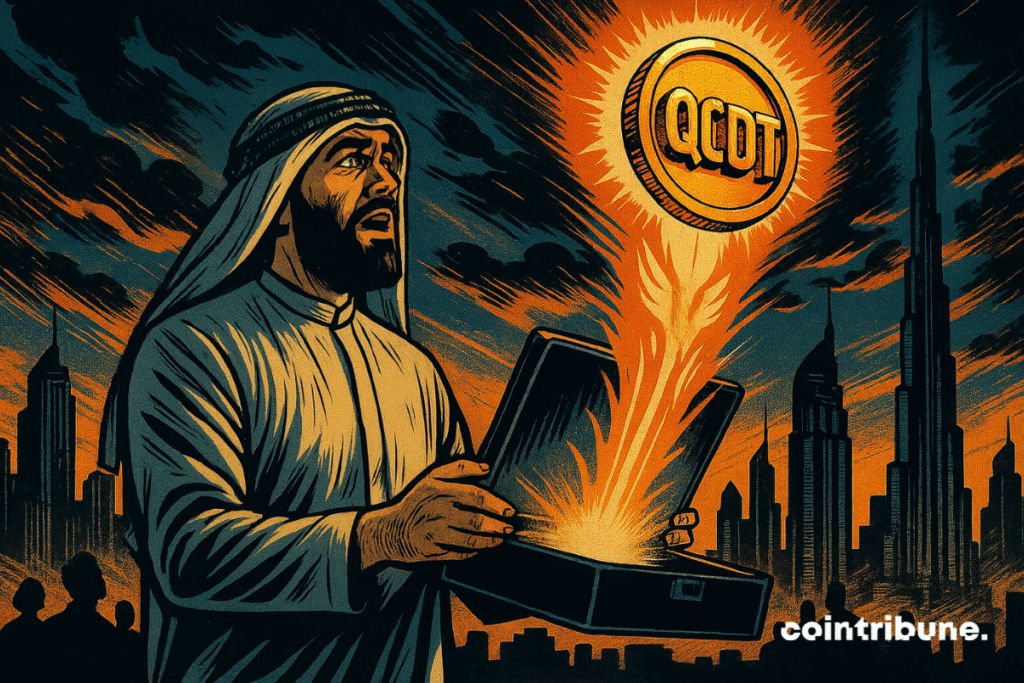Dubai’s Tokenized Asset Market Takes Off with Groundbreaking Fund Launch
Dubai loves to surprise. But rarely by chance. For several years now, the emirate has been rolling out a clear strategy: to create a global hub where innovation and regulation go hand in hand. While some countries still hesitate to designate a crypto asset in their commercial law, others are already building bridges. And in the desert, an ecosystem structured around tokenization is rising, stone by stone.

In Brief
- The QCDT is the first tokenized fund approved in the DIFC financial center in Dubai.
- It combines traditional banking management and blockchain technologies operated by DMZ Finance for greater transparency.
- Assets can serve as collateral, backing of stablecoins, or reserve for institutional Web3 services.
- This tokenized model is designed to be exported while remaining compliant with local regulatory requirements.
Dubai lays a solid first stone on the TradFi-crypto bridge
The ink that covered the TOKEN2049 in Dubai is not yet dry when the spotlight already turns to another major announcement. The news has circulated through institutional circles: the QCD Money Market Fund (QCDT), a tokenized money market fund, has just received official approval from the DFSA regulator. A world first in the regulated crypto ecosystem. Designed by Qatar National Bank (QNB) and DMZ Finance, this hybrid product symbolizes the fusion between traditional finance and blockchain technology.
QNB handles traditional management – asset management, compliance, yield. DMZ powers the technological layer with decentralized infrastructures. So it is not just another dematerialized product, but a tokenized asset with multiple functions: it can serve as collateral for banks, backing for stablecoins, or as a liquidity reserve on Web3 protocols.
In the official statement, Silas Lee (QNB Singapore) states:
QCDT is not only the first DFSA-approved tokenized money market fund in Dubai but also a pivotal step in QNB’s digital asset journey. It marks a new phase in our strategic roadmap and lays a strong foundation for the future of multi-asset tokenization.
This fund could well become an exportable model. Because Dubai is not just experimenting; it wants to industrialize tokenization.
What the QCDT truly changes for tokenized finance
The legal framework put in place by the DFSA provides the QCDT with unprecedented playing ground. Each player knows their role. No ambiguity. The product retains traditional finance guarantees while being fully traceable on-chain.
Crypto lawyer Desmond Tatsi explains it as follows:
The DFSA’s approach demonstrates a nuanced understanding that tokenization doesn’t fundamentally alter the nature of the underlying asset—it merely transforms the medium through which ownership is recorded and transferred.
The QCDT’s design is based on a dual architecture: fund administration is managed by QNB, while DMZ Finance handles the tokenization of shares, with transparency, auditability, and Web3 compatibility. This paves the way for smoother institutional adoption, where crypto is no longer frightening.
Why the Middle East is rushing into real asset tokenization
Dubai is not simply riding a trend. The emirate wants to become the regional hub for real asset tokenization. This ambition is shared by its neighbors. Qatar, for example, already permits certain tokenized products within its special financial zone. But Dubai is going further.
The DFSA regulator pursues a proactive strategy: framing uses, certifying structures, while attracting global finance giants. The infrastructures set up allow projects like QCDT to be regulated, scalable, and interoperable at the same time.
The message sent to investors is clear: here, crypto is not marginal, it is managed. This positioning builds trust, especially for alternative funds, stablecoins, or on-chain institutional financing tools.
Key numbers to remember:
- The global market for tokenized real assets is projected to reach $18.9 trillion by 2033;
- $420 million in private credit, $87 million in US Treasury bonds, $31 million in alternative funds are already on the blockchain;
- BlackRock’s BUIDL fund captures 30% of the tokenized Treasury market;
- The QCDT is the first regulated tokenized fund in the DIFC;
- The region aims to become a global benchmark in RWA (Real World Assets).
Hard to fall off one’s chair. Dubai is no stranger to this. The emirate has already opened its doors to Binance, Ripple, and dozens of crypto platforms. In January 2023, more than 500 companies in the sector were established there, proof that this new tokenized offensive is part of a carefully constructed strategic line.
Maximize your Cointribune experience with our "Read to Earn" program! For every article you read, earn points and access exclusive rewards. Sign up now and start earning benefits.
La révolution blockchain et crypto est en marche ! Et le jour où les impacts se feront ressentir sur l’économie la plus vulnérable de ce Monde, contre toute espérance, je dirai que j’y étais pour quelque chose
The views, thoughts, and opinions expressed in this article belong solely to the author, and should not be taken as investment advice. Do your own research before taking any investment decisions.